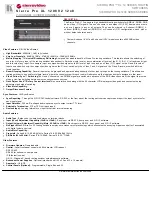
Level-1 Metric Style
Level-2 Metric Style
Resulting Metric Value
narrow transition
wide
original value
narrow transition
narrow
original value
narrow transition
wide transition
original value
narrow transition
transition
original value
transition
wide
original value
transition
narrow
original value
transition
wide transition
original value
transition
narrow transition
original value
wide transition
wide
original value
wide transition
narrow
truncated value
wide transition
narrow transition
truncated value
wide transition
transition
truncated value
Sample Configurations
The following configurations are examples for enabling IPv6 IS-IS. These examples are not
comprehensive directions. They are intended to give you some guidance with typical configurations.
NOTE: Only one IS-IS process can run on the router, even if both IPv4 and IPv6 routing is being
used.
You can copy and paste from these examples to your CLI. To support your own IP addresses, interfaces,
names, and so on, be sure that you make the necessary changes.
NOTE: Whenever you make IS-IS configuration changes, clear the IS-IS process (re-started) using
the
clear isis
command. The
clear isis
command must include the tag for the ISIS process.
The following example shows the response from the router:
Dell#clear isis *
% ISIS not enabled.
Dell#clear isis 9999 *
You can configure IPv6 IS-IS routes in one of the following three different methods:
•
Congruent Topology
— You
must
configure both IPv4 and IPv6 addresses on the interface. Enable
the
ip router isis
and
ipv6 router isis
commands on the interface. Enable the
wide-
metrics
parameter in router isis configuration mode.
•
Multi-topology
— You
must
configure the IPv6 address. Configuring the IPv4 address is optional. You
must
enable the
ipv6 router isis
command on the interface. If you configure IPv4, also enable
the
router isis
command. In router isis configuration mode, enable
multi-topology
under
address-family ipv6 unicast.
•
Multi-topology Transition
— You
must
configure the IPv6 address. Configuring the IPv4 address is
optional. You
must
enable the
ipv6 router isis
command on the interface. If you configure IPv4,
also enable the
ip router isis
command. In router isis configuration mode, enable
multi-
topology transition
under address-family ipv6 unicast.
Intermediate System to Intermediate System
557
Summary of Contents for S4820T
Page 1: ...Dell Configuration Guide for the S4820T System 9 8 0 0 ...
Page 282: ...Dell 282 Control Plane Policing CoPP ...
Page 622: ...Figure 81 Configuring Interfaces for MSDP 622 Multicast Source Discovery Protocol MSDP ...
Page 623: ...Figure 82 Configuring OSPF and BGP for MSDP Multicast Source Discovery Protocol MSDP 623 ...
Page 629: ...Figure 86 MSDP Default Peer Scenario 2 Multicast Source Discovery Protocol MSDP 629 ...
Page 630: ...Figure 87 MSDP Default Peer Scenario 3 630 Multicast Source Discovery Protocol MSDP ...
Page 751: ...10 11 5 2 00 00 05 00 02 04 Member Ports Te 1 2 1 PIM Source Specific Mode PIM SSM 751 ...
Page 905: ...Figure 112 Single and Double Tag First byte TPID Match Service Provider Bridging 905 ...
Page 979: ...6 Member not present 7 Member not present Stacking 979 ...
Page 981: ...storm control Storm Control 981 ...
Page 1103: ...Figure 134 Setup OSPF and Static Routes Virtual Routing and Forwarding VRF 1103 ...
















































